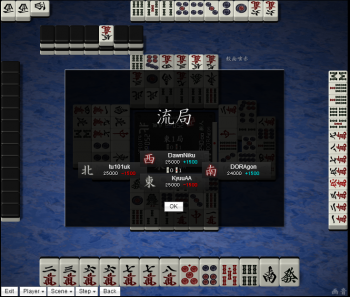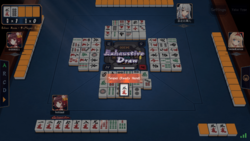Ryuukyoku

Ryuukyoku 「流局」, or exhaustive draw, is a way of ending a hand. It occurs when all the tiles (excluding those in the dead wall) have been drawn, and no player manages to produce a winning hand. After the player with the last tile draw makes a discard, if no one claims a win, then the hand simply ends in "exhaustive draw". During an exhaustive draw:
- Players in tenpai reveal their hands, then receive points from players who are in noten (not tenpai).
- Wind seats may rotate, depending on the dealer's hand and the ruleset.
- The honba count increases by 1.
Afterwards, a new hand starts. While the term "ryuukyoku" is usually used to refer to an exhaustive draw in Japanese, on occasion this may be ambiguous, as the term technically refers to any draw (cf. tochuu ryuukyoku, 「途中流局」). When ambiguity occurs, it may be referred to as tsuujou no ryuukyoku 「通常の流局」, which translates roughly as "usual kind of draw".
Rule overview
Unless a chombo occurs, the following happens during an exhaustive draw:
Point Exchanges
If some players are tenpai and others are not, points are exchanged. The players in noten pay a combined sum of 3000 points, split between players in tenpai. This results in the following score table:
- 0 players in tenpai: No points exchanged.
- 1 player in tenpai: All players in noten pay 1,000 points to the tenpai player.
- 2 players in tenpai: Each player in noten pays 1,500 points, each player in tenpai receives 1,500 points.
- 3 players in tenpai: The single player in noten pays 1,000 points to each player in tenpai.
- 4 players in tenpai: No points exchanged.
If a player qualifies for nagashi mangan, all point exchanges from tenpai are skipped. Instead, players pay a "mangan tsumo" to the players with nagashi mangan. The dealer pays 4000 points and other non-dealers pay 2000 points to each non-dealer with nagashi mangan; all non-dealers pay 4000 to the dealer with nagashi mangan.
Any riichi bets left on the table are saved for later rounds. The next player that wins claims all leftover riichi bets.
Players in noten are not required to reveal their hands. When playing with physical tiles, players in tenpai may (intentionally or not) declare noten, losing out on the tenpai points.
See the Tenpai section below for the general definition of "tenpai" used by ryuukyoku.
Seat rotation
Wind seat rotation is dependent on the dealer's hand state and the ruleset.
- Agari renchan: Seats are kept only when the dealer wins; this means that seats always rotate after an exhaustive draw.
- Tenpai renchan: Seats are kept when the dealer wins, or if the dealer is tenpai at exhaustive draw. If the dealer is noten, seats rotate.
Regardless of rotation, after an exhaustive draw, the honba count increases by 1.
Tenpai
Tenpai is the state of the hand waiting on just one tile to claim for a win, either by draw or discard. When an exhaustive draw happens, a win is no longer possible, but a small point bonus is given.
Karaten

A hand may be in the shape of tenpai, but unable to win through actual gameplay. For example, if all of the winning tiles are discarded, a hand can be seen as tenpai but unable to win. This is known as karaten.
Whether such hands count as tenpai depends on rule variation. Under many rulesets:
- A hand with no yaku counts as tenpai for ryuukyoku.
- A hand in furiten counts as tenpai.
- A hand with all possible winning tiles discarded (or otherwise unavailable) counts as tenpai.
- A hand with all possible winning tiles in the player's own hand (see below) does not count as tenpai.
For an example of the last case:
Despite the hand being one tile away from completion, all of the possible winning tiles are in the player's own closed kan, so the hand may be considered noten. (However, this is subject to rule variation.)
Chombo
A player is not allowed to call a riichi without tenpai. If a player declares noten riichi, and the hand ends in ryuukyoku, the player is penalized for chombo.
No wind rotation is applied, and no point exchanges are applied. The honba count is not increased. The next hand continues as if the chombo hand did not even occur. Of course, the appropriate penalty for chombo is applied and the game continues.
Strategy
Sometimes, the ryuukyoku point exchanges is enough to determine the final position in games, especially in all last. Dealers in tight point races need to take particular note about the need to attain tenpai or allow the game to end. It is occasionally desirable to pass on a small winning hand in order to collect the payment from noten players, though this comes at the risk of opponent tsumo.
Since players often abandon the hand after a player declares riichi, the exhaustive draw rate is quite high in professional play:
- Around 15.5% of Tenhou hands in the Houou lobby go to an exhaustive draw.[1]
- Around 23.5% of M League hands in the 2022-2023 regular season went to an exhaustive draw.[2]
References
- ↑ https://pathofhouou.blogspot.com/2019/08/analysis-average-houou-game.html
- ↑ https://web.archive.org/web/20230605101538/https://m-league.jp/stats/?season=L001_S013
While the exhaustive draw rate is not displayed, it can be calculated. Since M League uses atamahane and does not have abortive draws, all games either end in a single win or an exhaustive draw. Therefore,(average win rate * 4) + (exhaustive draw rate) = 100%of games. The average win rate is 19.125%, so the exhaustive draw rate is 23.5%.
External links
- Ryuukyoku in Japanese Wikipedia